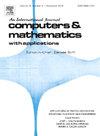Energy-stable linear convex splitting methods for the parabolic sine-Gordon equation
IF 2.5
2区 数学
Q1 MATHEMATICS, APPLIED
引用次数: 0
Abstract
We propose a linear convex splitting approach for the parabolic sine-Gordon equation. This linear formulation ensures unique solvability and high computational efficiency. When combined with a convex splitting Runge–Kutta method, it achieves high-order temporal accuracy and unconditional energy stability. For the first-order scheme, we establish the discrete maximum principle, a notable property of the parabolic sine-Gordon equation, although this principle is observed to be numerically violated in the second-order scheme. Spatial discretization is performed employing a standard second-order accurate finite difference method. Numerical experiments are provided to validate the accuracy, energy stability, and dynamic behavior of the proposed schemes.
抛物型正弦-戈登方程的能量稳定线性凸分裂方法
提出了一种求解抛物型正弦-戈登方程的线性凸分裂方法。这种线性公式保证了独特的可解性和较高的计算效率。当与凸分裂龙格-库塔方法相结合时,该方法获得了高阶时间精度和无条件能量稳定性。对于一阶格式,我们建立了离散极大值原理,这是抛物型正弦-戈登方程的一个显著性质,尽管在二阶格式中观察到该原理在数值上被违反。采用标准二阶精确有限差分法进行空间离散化。数值实验验证了所提方案的精度、能量稳定性和动力性能。
本文章由计算机程序翻译,如有差异,请以英文原文为准。
求助全文
约1分钟内获得全文
求助全文
来源期刊

Computers & Mathematics with Applications
工程技术-计算机:跨学科应用
CiteScore
5.10
自引率
10.30%
发文量
396
审稿时长
9.9 weeks
期刊介绍:
Computers & Mathematics with Applications provides a medium of exchange for those engaged in fields contributing to building successful simulations for science and engineering using Partial Differential Equations (PDEs).
 求助内容:
求助内容: 应助结果提醒方式:
应助结果提醒方式:


